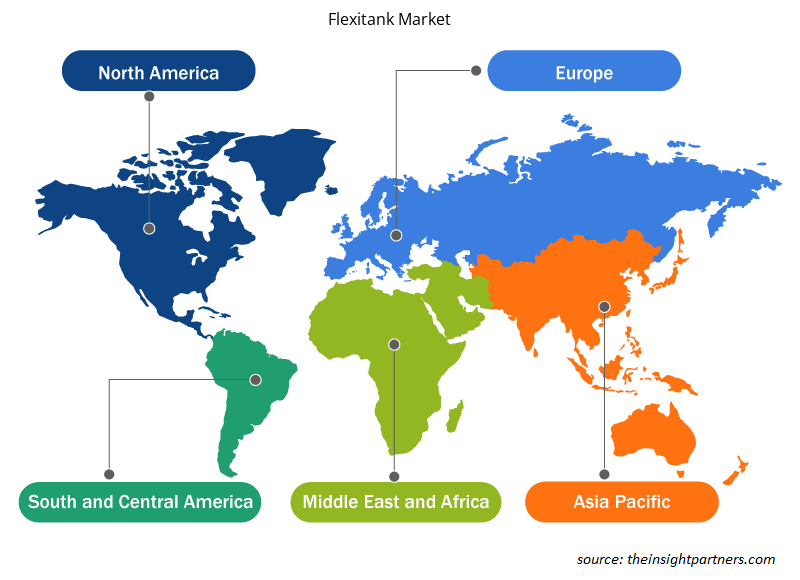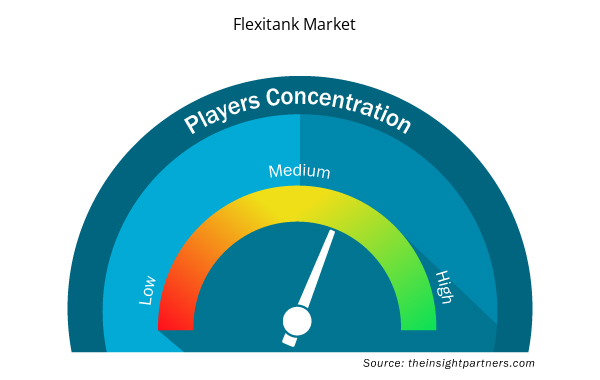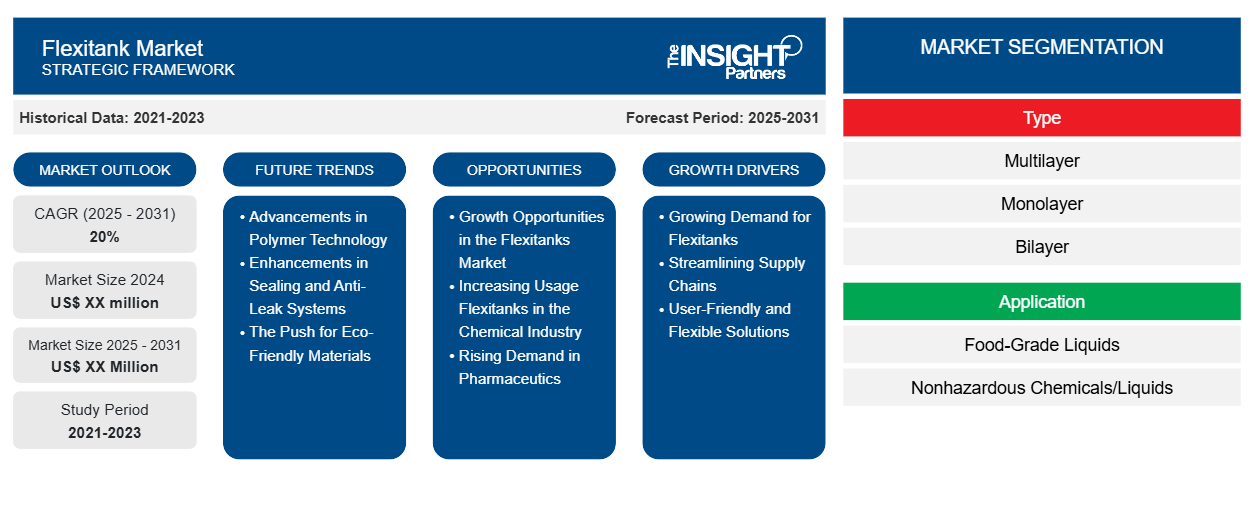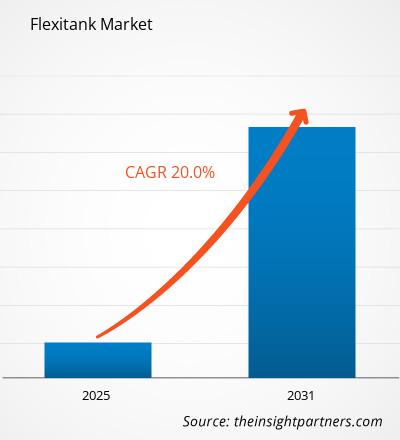Si prevede che il mercato Flexitank registrerà un CAGR del 20% dal 2024 al 2031, con una dimensione di mercato in espansione da XX milioni di dollari USA nel 2024 a XX milioni di dollari USA entro il 2031.
Il rapporto presenta analisi basate sul tipo (multistrato, monostrato e bistrato). Il rapporto è segmentato per applicazione (liquidi di qualità alimentare, prodotti chimici/liquidi non pericolosi e altri). L'analisi globale è ulteriormente suddivisa a livello regionale e nei principali paesi. Le dimensioni del mercato e le previsioni a livello globale, regionale e nazionale per tutti i segmenti di mercato chiave sono coperte nell'ambito. Il rapporto offre il valore in USD per l'analisi e i segmenti di cui sopra. Il rapporto fornisce statistiche chiave sullo stato di mercato dei principali attori del mercato e offre tendenze e opportunità di mercato.
Scopo del rapporto
Il report Flexitank Market di The Insight Partners mira a descrivere il panorama attuale e la crescita futura, i principali fattori trainanti, le sfide e le opportunità. Ciò fornirà spunti a vari stakeholder aziendali, come:
- Fornitori/produttori di tecnologia: per comprendere le dinamiche di mercato in evoluzione e conoscere le potenziali opportunità di crescita, consentendo loro di prendere decisioni strategiche informate.
- Investitori: condurre un'analisi completa delle tendenze in merito al tasso di crescita del mercato, alle proiezioni finanziarie del mercato e alle opportunità esistenti lungo la catena del valore.
- Enti di regolamentazione: regolamentano le politiche e le attività di controllo sul mercato allo scopo di ridurre al minimo gli abusi, preservare la fiducia degli investitori e sostenere l'integrità e la stabilità del mercato.
Segmentazione del mercato Flexitank
Tipo
- Multistrato
- Monostrato
- Doppio strato
Applicazione
- Liquidi di qualità alimentare
- Prodotti chimici/liquidi non pericolosi
Personalizza questo report in base alle tue esigenze
Riceverai la personalizzazione gratuita di qualsiasi report, comprese parti di questo report, o analisi a livello nazionale, pacchetto dati Excel, oltre a usufruire di grandi offerte e sconti per start-up e università
- Scopri le principali tendenze di mercato in questo rapporto.Questo campione GRATUITO includerà analisi di dati che spaziano dalle tendenze di mercato alle stime e alle previsioni.
Fattori di crescita del mercato Flexitank
- Domanda crescente di Flexitank: i Flexitank sono molto richiesti come mezzo conveniente per spedire liquidi alla rinfusa in modo economicamente efficace. La crescente necessità di un trasporto efficiente di merci liquide sta guidando la domanda all'interno del mercato. I settori alimentare e delle bevande, chimico e farmaceutico stanno utilizzando i Flexitank poiché ottimizzano lo spazio all'interno dei contenitori.
- Semplificazione delle catene di fornitura: con l'espansione del commercio internazionale, le aziende avranno bisogno di soluzioni fantasiose per semplificare i processi della loro catena di fornitura. I Flexitank consentono di spostare più volumi di liquidi in normali container per la spedizione. Questa efficienza consente di risparmiare sui costi di spedizione e contribuisce a ridurre il degrado ambientale, fattori che potrebbero far parte degli obiettivi di sostenibilità che la maggior parte delle organizzazioni sta cercando di raggiungere.
- Soluzioni flessibili e facili da usare: inoltre, le flexitank sono spuntate perché sono facili da usare e flessibili. Sono più veloci da montare e comportano meno pulizie rispetto alle cisterne tradizionali. La flessibilità a questo ritmo veloce del mercato è fondamentale in termini sia di tempo che di risorse. Le aziende puntano all'efficienza nelle operazioni e quindi continuano a ordinare queste soluzioni.
Tendenze future del mercato Flexitank
- Progressi nella tecnologia dei polimeri: le innovazioni nella tecnologia dei polimeri, unite alle nuove scoperte nella scienza dei materiali che potrebbero dare il via a una nuova era di materiali più robusti, leggeri e tuttavia più affidabili e durevoli, hanno portato i consumatori ad apprezzare la maggiore sicurezza e affidabilità associate ai flexitank.
- Miglioramenti nei sistemi di tenuta e anti-perdita: nuovi design, tra cui sistemi di tenuta e anti-perdita migliori, stanno contribuendo alla crescita del mercato. Queste caratteristiche evitano la contaminazione e le perdite, che sono state la principale fonte di preoccupazione per molti produttori e fornitori di servizi logistici. Le aziende stanno ora optando per metodi di trasporto sicuri e protetti e gli aggiornamenti tecnologici in tali parametri stanno diventando sempre più essenziali per soddisfare gli standard industriali.
- La spinta verso materiali eco-compatibili: inoltre, i materiali eco-compatibili costituiscono un'area di ricerca in forte crescita. Con l'attenzione rivolta al verde, i produttori di flexitank esplorano materiali biodegradabili o riciclabili in quanto possono ridurre l'esposizione ai danni ambientali e attrarre aziende attente al verde per sostenere una base di clienti eco-compatibili.
Opportunità di mercato del Flexitank
- Opportunità di crescita nel mercato dei Flexitank: l'espansione in altri settori come quello chimico, farmaceutico e cosmetico offre grandi opportunità di crescita per il mercato dei Flexitank, non più limitato al settore alimentare e delle bevande, dove il suo utilizzo iniziale riguardava principalmente il trasporto di liquidi.
- Utilizzo crescente di Flexitank nell'industria chimica: nell'industria chimica, è emersa di recente come pratica comune il trasporto di liquidi non pericolosi in flexitank, offrendo un'alternativa economica alle tradizionali opzioni di cisterne. I flexitank sono grandi tubi prefabbricati, realizzati in materiale flessibile in plastica/PVC. Accolgono la spedizione alla rinfusa mantenendo l'integrità del prodotto. I produttori che hanno bisogno di una soluzione logistica molto efficiente lo trovano interessante. Questa sarebbe una tendenza salutare per applicazioni che comprendono una gamma molto più ampia di merci liquide.
- Domanda crescente nel settore farmaceutico: il settore farmaceutico acquisisce valore anche nell'uso di flexitank per trasportare grandi volumi di liquidi, tra cui vaccini e altre forniture mediche. Oltre ai vantaggi dell'uso di flexitank, come la limitazione dei rischi di contaminazione e la garanzia della qualità del prodotto, si aggiunge la necessità di metodi di trasporto sicuri e affidabili. L'accettazione dei prodotti farmaceutici sta crescendo con questi sviluppi attuali, con un buon andamento della domanda in futuro.
Approfondimenti regionali sul mercato Flexitank
Le tendenze regionali e i fattori che influenzano il mercato Flexitank durante il periodo di previsione sono stati ampiamente spiegati dagli analisti di Insight Partners. Questa sezione discute anche i segmenti e la geografia del mercato Flexitank in Nord America, Europa, Asia Pacifico, Medio Oriente e Africa, e Sud e Centro America.

- Ottieni i dati specifici regionali per il mercato Flexitank
Ambito del rapporto di mercato Flexitank
| Attributo del report | Dettagli |
|---|---|
| Dimensioni del mercato nel 2024 | XX milioni di dollari USA |
| Dimensioni del mercato entro il 2031 | XX milioni di dollari USA |
| CAGR globale (2025 - 2031) | 20% |
| Dati storici | 2021-2023 |
| Periodo di previsione | 2025-2031 |
| Segmenti coperti | Per tipo
|
| Regioni e Paesi coperti | America del Nord
|
| Leader di mercato e profili aziendali chiave |
|
Densità degli attori del mercato Flexitank: comprendere il suo impatto sulle dinamiche aziendali
Il mercato Flexitank Market sta crescendo rapidamente, spinto dalla crescente domanda degli utenti finali dovuta a fattori quali l'evoluzione delle preferenze dei consumatori, i progressi tecnologici e una maggiore consapevolezza dei vantaggi del prodotto. Con l'aumento della domanda, le aziende stanno ampliando le loro offerte, innovando per soddisfare le esigenze dei consumatori e capitalizzando sulle tendenze emergenti, il che alimenta ulteriormente la crescita del mercato.
La densità degli operatori di mercato si riferisce alla distribuzione di aziende o società che operano in un particolare mercato o settore. Indica quanti concorrenti (operatori di mercato) sono presenti in un dato spazio di mercato in relazione alle sue dimensioni o al valore di mercato totale.
Le principali aziende che operano nel mercato Flexitank sono:
- Nato
- Trasporto di liquidi alla rinfusa
- Büscherhoff Packaging Solutions GmbH
- FIDATI dei Flexitank
- Il marchio Hillebrand
Disclaimer : le aziende elencate sopra non sono classificate secondo un ordine particolare.

- Ottieni la panoramica dei principali attori del mercato Flexitank
Punti di forza chiave
- Copertura completa: il rapporto esamina in modo completo i prodotti, i servizi, le tipologie e gli utenti finali del mercato Flexitank, fornendo una panoramica olistica.
- Analisi degli esperti: il rapporto è compilato sulla base della conoscenza approfondita di esperti e analisti del settore.
- Informazioni aggiornate: il rapporto garantisce la pertinenza aziendale grazie alla copertura di informazioni recenti e tendenze nei dati.
- Opzioni di personalizzazione: questo report può essere personalizzato per soddisfare le esigenze specifiche del cliente e adattarsi in modo appropriato alle strategie aziendali.
Il rapporto di ricerca sul mercato Flexitank può quindi aiutare a guidare il percorso di decodifica e comprensione dello scenario del settore e delle prospettive di crescita. Sebbene possano esserci alcune preoccupazioni valide, i vantaggi complessivi di questo rapporto tendono a superare gli svantaggi.
- Analisi storica (2 anni), anno base, previsione (7 anni) con CAGR
- Analisi PEST e SWOT
- Valore/volume delle dimensioni del mercato - Globale, regionale, nazionale
- Industria e panorama competitivo
- Set di dati Excel


- Electronic Data Interchange Market
- Intradermal Injection Market
- Hummus Market
- Artificial Turf Market
- Small Molecule Drug Discovery Market
- Electronic Signature Software Market
- Legal Case Management Software Market
- Point of Care Diagnostics Market
- Medical and Research Grade Collagen Market
- Microcatheters Market

Report Coverage
Revenue forecast, Company Analysis, Industry landscape, Growth factors, and Trends

Segment Covered
This text is related
to segments covered.

Regional Scope
North America, Europe, Asia Pacific, Middle East & Africa, South & Central America

Country Scope
This text is related
to country scope.
Domande frequenti
Technological advancements in flexitank materials and design is expected to be the key market trends.
Based on type, the multilayer segment is expected to witness the fastest growth during the forecast period
Based on geography, Asia Pacific held the largest share of the flexitank market as governments of various countries in Asia Pacific are concentrating on expanding exports, which is expected to provide lucrative opportunities to the market.
The growing demand for efficient liquid cargo transportation is driving the market growth.
Bornit; Bulk Liquid Transport; Büscherhoff Packaging Solutions GmbH; TRUST Flexitanks; Hillebrand; MY FlexiTank (MYF); Kricon Group; Qingdao LAF Packaging Co., Ltd.; Bulk Liquid Solutions; and Abrao Group are some of the key players operating in the flexitank market
The Flexitank Market is estimated to witness a CAGR of 20% from 2023 to 2031
The List of Companies
- Bornit
- Bulk Liquid Transport
- Büscherhoff Packaging Solutions GmbH
- TRUST Flexitanks
- Hillebrand
- MY FlexiTank (MYF)
- Kricon Group
- Qingdao LAF Packaging Co., Ltd.
- Bulk Liquid Solutions
- Abrao Group
The Insight Partners performs research in 4 major stages: Data Collection & Secondary Research, Primary Research, Data Analysis and Data Triangulation & Final Review.
- Data Collection and Secondary Research:
As a market research and consulting firm operating from a decade, we have published and advised several client across the globe. First step for any study will start with an assessment of currently available data and insights from existing reports. Further, historical and current market information is collected from Investor Presentations, Annual Reports, SEC Filings, etc., and other information related to company’s performance and market positioning are gathered from Paid Databases (Factiva, Hoovers, and Reuters) and various other publications available in public domain.
Several associations trade associates, technical forums, institutes, societies and organization are accessed to gain technical as well as market related insights through their publications such as research papers, blogs and press releases related to the studies are referred to get cues about the market. Further, white papers, journals, magazines, and other news articles published in last 3 years are scrutinized and analyzed to understand the current market trends.
- Primary Research:
The primarily interview analysis comprise of data obtained from industry participants interview and answers to survey questions gathered by in-house primary team.
For primary research, interviews are conducted with industry experts/CEOs/Marketing Managers/VPs/Subject Matter Experts from both demand and supply side to get a 360-degree view of the market. The primary team conducts several interviews based on the complexity of the markets to understand the various market trends and dynamics which makes research more credible and precise.
A typical research interview fulfils the following functions:
- Provides first-hand information on the market size, market trends, growth trends, competitive landscape, and outlook
- Validates and strengthens in-house secondary research findings
- Develops the analysis team’s expertise and market understanding
Primary research involves email interactions and telephone interviews for each market, category, segment, and sub-segment across geographies. The participants who typically take part in such a process include, but are not limited to:
- Industry participants: VPs, business development managers, market intelligence managers and national sales managers
- Outside experts: Valuation experts, research analysts and key opinion leaders specializing in the electronics and semiconductor industry.
Below is the breakup of our primary respondents by company, designation, and region:

Once we receive the confirmation from primary research sources or primary respondents, we finalize the base year market estimation and forecast the data as per the macroeconomic and microeconomic factors assessed during data collection.
- Data Analysis:
Once data is validated through both secondary as well as primary respondents, we finalize the market estimations by hypothesis formulation and factor analysis at regional and country level.
- Macro-Economic Factor Analysis:
We analyse macroeconomic indicators such the gross domestic product (GDP), increase in the demand for goods and services across industries, technological advancement, regional economic growth, governmental policies, the influence of COVID-19, PEST analysis, and other aspects. This analysis aids in setting benchmarks for various nations/regions and approximating market splits. Additionally, the general trend of the aforementioned components aid in determining the market's development possibilities.
- Country Level Data:
Various factors that are especially aligned to the country are taken into account to determine the market size for a certain area and country, including the presence of vendors, such as headquarters and offices, the country's GDP, demand patterns, and industry growth. To comprehend the market dynamics for the nation, a number of growth variables, inhibitors, application areas, and current market trends are researched. The aforementioned elements aid in determining the country's overall market's growth potential.
- Company Profile:
The “Table of Contents” is formulated by listing and analyzing more than 25 - 30 companies operating in the market ecosystem across geographies. However, we profile only 10 companies as a standard practice in our syndicate reports. These 10 companies comprise leading, emerging, and regional players. Nonetheless, our analysis is not restricted to the 10 listed companies, we also analyze other companies present in the market to develop a holistic view and understand the prevailing trends. The “Company Profiles” section in the report covers key facts, business description, products & services, financial information, SWOT analysis, and key developments. The financial information presented is extracted from the annual reports and official documents of the publicly listed companies. Upon collecting the information for the sections of respective companies, we verify them via various primary sources and then compile the data in respective company profiles. The company level information helps us in deriving the base number as well as in forecasting the market size.
- Developing Base Number:
Aggregation of sales statistics (2020-2022) and macro-economic factor, and other secondary and primary research insights are utilized to arrive at base number and related market shares for 2022. The data gaps are identified in this step and relevant market data is analyzed, collected from paid primary interviews or databases. On finalizing the base year market size, forecasts are developed on the basis of macro-economic, industry and market growth factors and company level analysis.
- Data Triangulation and Final Review:
The market findings and base year market size calculations are validated from supply as well as demand side. Demand side validations are based on macro-economic factor analysis and benchmarks for respective regions and countries. In case of supply side validations, revenues of major companies are estimated (in case not available) based on industry benchmark, approximate number of employees, product portfolio, and primary interviews revenues are gathered. Further revenue from target product/service segment is assessed to avoid overshooting of market statistics. In case of heavy deviations between supply and demand side values, all thes steps are repeated to achieve synchronization.
We follow an iterative model, wherein we share our research findings with Subject Matter Experts (SME’s) and Key Opinion Leaders (KOLs) until consensus view of the market is not formulated – this model negates any drastic deviation in the opinions of experts. Only validated and universally acceptable research findings are quoted in our reports.
We have important check points that we use to validate our research findings – which we call – data triangulation, where we validate the information, we generate from secondary sources with primary interviews and then we re-validate with our internal data bases and Subject matter experts. This comprehensive model enables us to deliver high quality, reliable data in shortest possible time.


 Ottieni un campione gratuito per questo repot
Ottieni un campione gratuito per questo repot